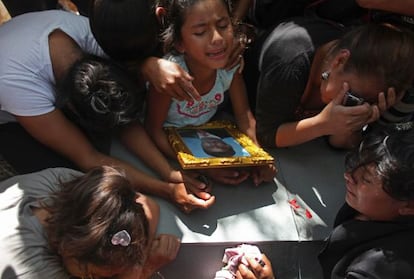Honduran prison fire was accidental
Forensics experts identify all bodies President Lobo pardons inmate "hero"

Last week's devastating fire at a prison in Honduras, which killed 360 inmates and serious injured dozens more, was likely caused by a candle or a cigarette that set fire to a mattress, a team of Honduran and US investigators said on Tuesday.
"The suspicion is that somebody was smoking or had a candle that started the fire. There was no criminal hand," said Daniela Ferrera, a senior investigator at the Honduran Attorney General's office.
The fire, which began on the evening of February 14 ripped through the overcrowded prison in Comayagua, just north of the capital Tegucigalpa, trapping many inmates in their jail cells as they fought to escape. Most of those who perished died from asphyxiation.
Initial reports said that the blaze was caused by rioting inmates, but a team of investigators from the US Bureau of Alcohol, Tobacco, Firearms and Explosives "was able to rule out other possible causes of the fire, such as a lightning strike, electrical causes, or the use of a flammable or combustible liquid," the US Embassy in Tegucigalpa said in a statement.
Honduran President Porfirio Lobo had asked the United States for help in investigating what is being called one of the worst prison fires in modern Latin American history.
Forensic experts on Tuesday completed the identification of all the bodies of the blaze victims. Anxious families rioted over the weekend outside Tegucigalpa's forensic institute after they complained that medical examiners were not working fast enough to return the bodies to them for proper burial.
Wary families have already pointed to some suspicious circumstances that occurred during the night of the emergency. One resident who lives nearby the Comayagua prison took a video in which gunshots can be heard while the fire ravaged the complex. Police, however, explained that that they were firing warning shots in the air to prevent the inmates from escaping.
At the time of the fire, there were 852 inmates being held in the Comayagua prison - a facility that was built to hold 250. Human rights groups complained that Honduras had not complied with a 2006 ruling by the Inter American Human Rights Court (CIDH) calling on the government to ease prison overcrowding. Among these groups calling on the Honduran government to undertake reforms to make changes to its penal system so that such tragedies are not repeated was the Washington-based Center for Justice and International Law.
On Tuesday, Honduran chief prosecutor Luis Alberto Rubí told a television station that witnesses said to investigators that a prisoner had fallen asleep while smoking.
"I think it is irresponsible for the prosecutor to mention isolated data instead of giving an integrated report," said Andrés Pavón, the president of the Human Rights Defense Commission. "It seems he is just throwing stuff out there."
Rubí also announced that President Lobo had granted a full pardon to a convicted murderer, Marco Antonio Bonilla, 50, who helped his fellow inmates escape the fire by breaking the locks to some of the cells.
Known as el chaparro (the short one) and el enfermero (the nurse), Bonilla still had more than four years to go on his 18-year prison term when he emerged as the hero of the Comayagua prison fire tragedy, according to the Tegucigalpa daily La Tribuna. He was convicted of murdering a man and wounding another during an attack on his 91-year-old father, the newspaper said.
Tu suscripción se está usando en otro dispositivo
¿Quieres añadir otro usuario a tu suscripción?
Si continúas leyendo en este dispositivo, no se podrá leer en el otro.
FlechaTu suscripción se está usando en otro dispositivo y solo puedes acceder a EL PAÍS desde un dispositivo a la vez.
Si quieres compartir tu cuenta, cambia tu suscripción a la modalidad Premium, así podrás añadir otro usuario. Cada uno accederá con su propia cuenta de email, lo que os permitirá personalizar vuestra experiencia en EL PAÍS.
¿Tienes una suscripción de empresa? Accede aquí para contratar más cuentas.
En el caso de no saber quién está usando tu cuenta, te recomendamos cambiar tu contraseña aquí.
Si decides continuar compartiendo tu cuenta, este mensaje se mostrará en tu dispositivo y en el de la otra persona que está usando tu cuenta de forma indefinida, afectando a tu experiencia de lectura. Puedes consultar aquí los términos y condiciones de la suscripción digital.








































